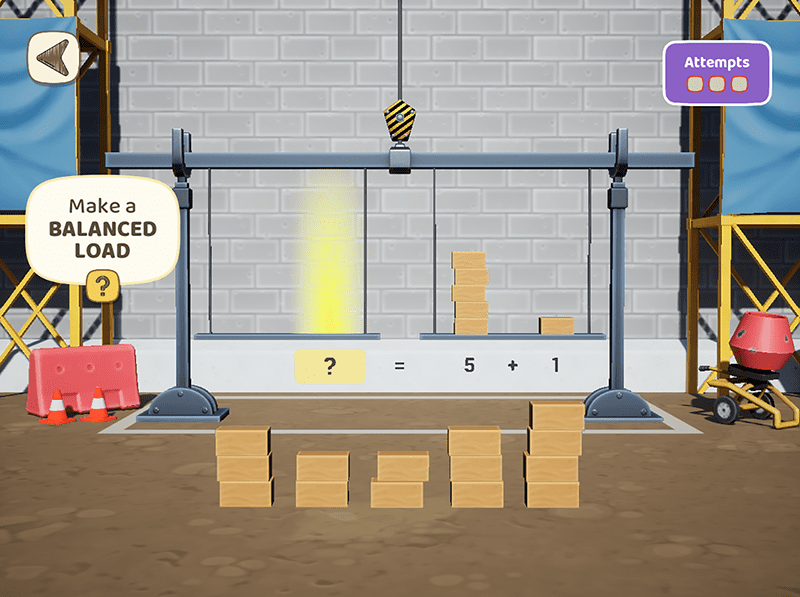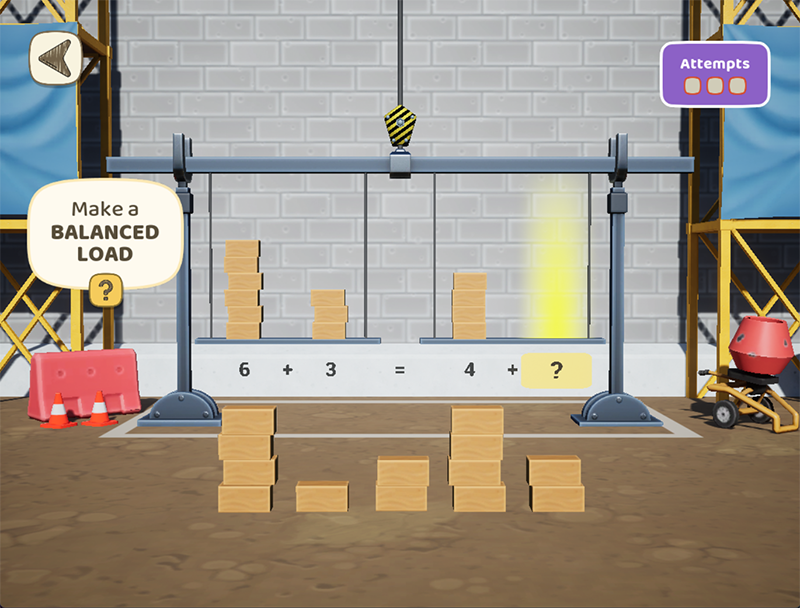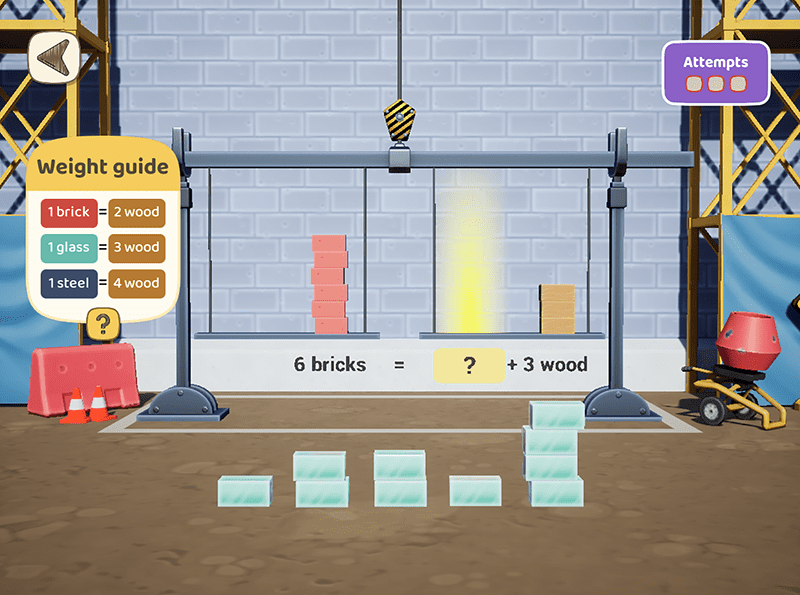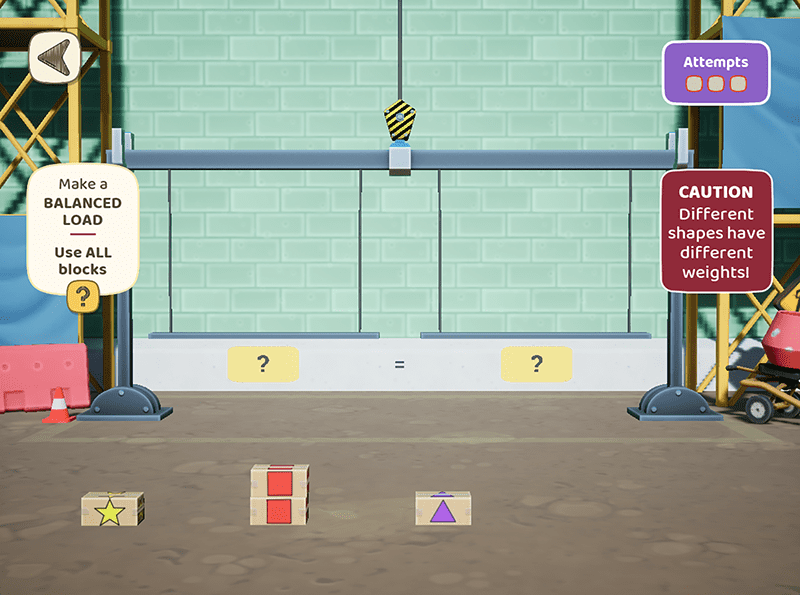Back to library
Maths in Town Squared: balance and equivalence on the Building Site
About these maths activities
In the Building Site game, children move building materials onto a platform to make it balance. The platform has two sides and a number sentence underneath, and the task is to add or take away materials until the amounts on both sides are equal. Children can test out their ideas about equivalence over multiple attempts. Success brings game rewards, while errors cause the blocks to fall off the platform, prompting the child to have another try.

All the Building Site puzzles involve loading building materials, like the wooden blocks here in the Frames activity, onto a platform to make it balance.
There are three activities in the Building Site game. In all activities, the task is to load up a platform with building materials so the builders on the floors above can keep working. The quantity and type of materials varies depending on the activity. In return for completing several loads, the child receives a quest ticket.
At the start of the activity, the mentor explains how to complete the task: drag items onto the platform, then tap the crane to test if it is balanced. There are piles of building materials along the bottom of the screen, two platforms side by side, and a number sentence underneath the platform with an equals sign in the middle. The number sentence displays a question mark over the part of the equation that can be changed, and the place to drop materials is highlighted. When materials are dragged on or off the platform, the question mark is replaced by the relevant number.
The child can keep moving items on or off the platform as they think through their answer, and the number sentence automatically updates whenever an item is added or removed. When they are ready to test their solution, they can tap the crane to start lifting. This approach allows children to think through their answers in their own time, and test for the solution when they feel ready.
If the number sentence is in balance, the platform lifts smoothly to the floors above. The builders immediately use the materials and celebrate the help they’ve received. The mentor shows their progress towards the quest ticket, and the next puzzle is presented. On each subsequent turn they get a different number sentence, with the difficulty increasing gradually over multiple turns.
If the number sentence is not balanced, the platforms topple and the building materials crash to the ground. The child then receives feedback and is encouraged to try again. The child gets 3 attempts at each equation; on the fourth try, the game presents a puzzle from an easier level.
There are three activities in the Building Site, each with a different type of equivalence challenge.
Frames
Children complete a number sentence by stacking wooden blocks that all have a value of 1. This is the easiest activity, using whole number addition or subtraction to balance the equation. It explores different ways that a number sentence can be written, and how the concept of balancing the equation is always consistent. It also helps children make a clear visual connection with the number of items on the platform and the way these amounts are represented in numerals below.

All the Building Site puzzles involve loading building materials, like the wooden blocks here in the Frames activity, onto a platform to make it balance.
Walls
Children complete a number sentence using blocks of different values. Children use a conversion table to work out how to balance the load on either side of the equals sign. This activity uses addition or subtraction in combination with multiplication to balance each load. Early levels use small quantities and simple number sentences, then gradually the quantities increase and sentences become more complex.

Building Site - Walls puzzles involve loading building materials with different values. You need to use the Weight guide to work out how to make it balance.
Decorations
Children construct a number sentence using all the available materials, which have unknown values. This is the most challenging activity and allows children to explore different strategies to work out the value of the boxes, and to construct the number sentence in any way they choose - as long as it balances!

Building Site - Decorations puzzles have building materials with different (consistent) values, but with no guide. You need to experiment to work out how to make it balance.
Information for teachers and educators
How does this puzzle relate to the Cambridge Big Ideas in Mathematics?
Cambridge University developed the Cambridge Big Ideas in Mathematics, based on concepts proposed by Randall I. Charles1. The Big Ideas described below help represent and teach maths as a connected and coherent area of learning, and they underpin the design of puzzles in Town Squared.
Big Idea 3: Equivalence
‘Any number, measure, numerical expression, algebraic expression, or equation can be represented in an infinite number of ways that have the same value.’
In the Building Site game, children can:
- complete or create a number sentence by physically moving puzzle elements, with visual guidance showing how those elements are represented in numerals.
- explore different ways that a number sentence can be constructed to be equal and balanced.
- use the game feedback mechanisms to test ideas of equivalence and try different strategies to achieve a successful result.
Big Idea 5: Operation meanings and relationships
‘The same number sentence (e.g. 12-4 = 8) can be associated with different concrete or real-world situations, AND different number sentences can be associated with the same concrete or real-world situation.’
In the Building Site game, children can:
- complete or construct number sentences using a real-world model (all activities)
- complete number sentences using addition or subtraction and blocks that all have a value of one. (Frames activity)
- complete number sentences using addition or subtraction in combination with multiplication, using blocks that have different values. Use a conversion table to work out the multipliers they need to balance a given number sentence. (Walls activity)
- construct their own number sentences with blocks of unknown values, starting with blocks that all have the same unknown value and gradually introducing other blocks that are unknown multiples. (Decorations activity)
How do the activities scale in complexity?
Each activity (Frames, Walls or Decorations) comprises a range of puzzles that use different mathematical concepts to explore the concept of equivalence. Overall, the series of three activities are intended to follow on and extend from each other in terms of complexity and the amount of scaffolding provided to help children complete the puzzles:
- Frames activity: foundation puzzles where all the blocks have the same value (1 block = 1) and the task involves addition or subtraction.
- Walls activity: mid-tier puzzles where blocks have different values, and the task involves adding or subtracting in multiples (2s, 3s, 4s).
- Decorations activity: the most complex puzzles where the values are unknown and the student must use all the blocks, in any combination that balances the equation.
All three activities can be accessed at any time so children can explore and experiment, and so teachers can direct them to a particular area of maths.
If a child makes an unsuccessful attempt at a puzzle, they receive feedback and are encouraged to try again. Multiple unsuccessful attempts automatically move them to puzzles with a lower level of complexity. This aims to ensure that children aren’t too discouraged, and to help teachers identify the challenge point for that child.
When children successfully complete the highest level of the activity, puzzles are chosen at random from the upper levels.
Frames activity
This is the simplest group of puzzles in the Building site, addressing addition and subtraction in different number sentences. Children must add or remove blocks from one stack on the platform, in order to balance the equation.
Early levels address simple correlation and number sentences that have a single digit on one side of the equation.
Later levels explore how a number sentence can have lots of different layouts, and increase the number of blocks in the answer.
|
Difficulty level |
This group of puzzles addresses these concepts |
|
Level 1 |
Add or subtract blocks anywhere on a platform to make an equation balance. All equations use a simple 1:1 correlation to introduce the core concepts of addition and subtraction. |
|
Level 2 |
Add or subtract blocks on the right of a platform to make an equation balance, with totals up to 9. All equations have 2 digits on the left and 1 on the right (a common number sentence construction). |
|
Level 3 |
Add or subtract blocks on the left of a platform to make an equation balance, with totals up to 9. All equations have 1 digit on the left and 2 on the right; explores balance in less common number sentence layouts. |
|
Level 4 |
Add or subtract blocks to balance an equation with totals between 4 and 10. All equations have 1 digit on one side and 2 on the other; explores the concept of equivalence in different equation layouts. |
|
Level 5 |
Add or subtract blocks on the right of an equation with two digits on both sides, to make totals between 4 and 10. Explores equations with operations on both sides of the equals sign. |
|
Level 6 |
Add or subtract blocks anywhere in an equation with two digits on both sides, to make totals between 8 and 12. Explores different ways to make both sides equivalent. |
|
Level 7 |
Add or subtract blocks anywhere in an equation with two digits on both sides, to make totals between 12 and 17. Uses larger totals to explore different ways to make both sides equivalent. |
Total number of puzzles: 84
Walls activity
This group of puzzles use blocks of different values, and provides a conversion chart for working out the values relative to the other blocks provided. This means the child must not only add or subtract blocks from the platform, they must compare the relative values and multiply to get the balance right.
- Early levels explore simple correlation, where (for example) adding one red brick is enough to balance the equivalent 2 wooden blocks.
- Mid levels use different block combinations to explore the range of ways a number sentence can be expressed.
- Later levels introduce increasingly complex combinations of materials and longer number sentences.
|
Difficulty level |
This group of puzzles addresses these concepts |
|
Level 1 |
Compare blocks of 2 different values, then move some on or off a platform to make an equation balance. All equations use a simple 1:1 correlation and compare the second material to the base value to introduce the core concept of multiplying. |
|
Level 2 |
Compare blocks of multiple different values and move some on or off a platform to make an equation balance. All equations use a simple 1:1 correlation to explore multiplying with different values. |
|
Level 3 |
Add or subtract blocks of multiple different values to balance an equation. All equations have two digits on one side and a single digit to complete on the opposite side. All equations require addition or subtraction in combination with multiplication. |
|
Level 4 |
Add or subtract blocks of multiple different values to balance an equation, where the active area is anywhere in the equation. All equations require addition or subtraction in combination with multiplication. |
|
Level 5 |
Work with multiple values to balance more complex equations than previously; the active area is anywhere in the equation. |
|
Level 6 |
Work with multiple values to balance more complex equations with higher totals than previously; the active area is anywhere in the equation. |
Total number of puzzles: 82
Decorations activity
These puzzles use boxes of building materials that are marked with different shapes. Each shape indicates that the box has a particular value; however, the builders have mislaid the conversion chart, so the values are unknown (note - a guide to the relative values is provided below, under the difficulty levels table).
The child must load all the boxes onto the platforms before the crane becomes active. They can stack them in any location, and in any pile they choose - the equation always updates to show the correct quantity of boxes, using each shape to represent them.
As the boxes are all the same size, the shapes and the value they represent become the most important consideration when calculating a balanced load. Children must work out a hypothesis for the value of each shape, and then decide how to use those values to construct a number sentence that balances.
Even when children have worked out the value of a shape, the puzzles still require mental maths skills to recall these values, compute the multiples, and stack all the boxes on either platform so the totals balance.
- The first few puzzles use only one shape at a time, simple correlation, and small quantities of boxes. There are only a few possible answers to each puzzle and this allows the child to experience early success with constructing their own number sentence and testing the results.
- Early levels then explore using two shapes of unknown value, where one shape is a multiple of the other. Middle levels explore using shapes with 2 or 3 different values, with gradually increasing totals.
- Later levels introduce one additional shape, and puzzles have 3 or 4 different shapes at a time with higher quantities and finally with all puzzles requiring a multiple.
|
Difficulty level |
This group of puzzles addresses these concepts |
|
Level 1 |
Move all the boxes onto the platform to construct a balanced equation. Introduces the concept of shapes of unknown value using a small quantity of boxes and one shape at a time. |
|
Level 2 |
Work out the relative value of two shapes and construct a balanced equation with a small quantity of boxes. |
|
Level 3 |
Use two previously-tried shapes to construct a balanced equation. Uses a larger quantity of boxes than previously. |
|
Level 4 |
Introduces a new shape. Balance an equation using a small quantity of boxes and work out the value of the new shape by comparing it with one other known shape. |
|
Level 5 |
Using the new shape, work out the values and balance equations using another known shape. Uses a larger quantity of boxes than previously. |
|
Level 6 |
Work with 3 shapes at once to balance a simple equation using a small quantity of boxes. |
|
Level 7 |
Work with 3 shapes at once to balance a more complex equation than previously seen, using a larger quantity of boxes. |
|
Level 8 |
Work with 3 shapes at once to construct even more complex equations with a larger number of boxes than previously. |
|
Level 9 |
Introduces a new shape. Balance an equation using a small quantity of boxes and work out the value of the new shape by comparing it with two established shapes. |
|
Level 10 |
Work with 4 shapes at once to balance an equation with a small quantity of boxes. Construct equations that have 3 or 4 possible values on each side. |
|
Level 11 |
Work with 4 shapes at once to balance an equation. Construct more complex equations with a larger quantity of boxes than previously. |
|
Level 12 |
Work with the 3 highest-value shapes to construct more complex equations. There are no ‘single unit’ shapes in these puzzles, so all maths is multiplicative. |
Total number of puzzles: 144
To see the relative values of the shapes in the Decorations puzzles, click on the heading below.
What are the shape values in the Decorations puzzles? (click to reveal)
The shape values in the Decoration puzzles are as follows:
- Star = 1
- Square = 2 (so 1 square = 2 stars)
- Triangle = 3 (so 1 triangle = 3 stars, or 1 square and 1 star)
- Hexagon = 4 (so 1 hexagon = 4 stars, or 2 squares, or … other combinations!)
Introducing early algebraic thinking
Played in order, the Building site activities gradually introduce early algebraic thinking to children.
- Frames works with standard number sentences
- Walls introduces values in the number sentence, using concrete representation (3 bricks, 2 steel, etc)
- Decorations moves to symbolic representations of values (squares, hexagons, etc).
How do these activities improve disposition towards maths and learning?
This group of puzzles applies the well-known maths tool of a balance arm to explore equivalence, while setting the task in the storyline of helping the townspeople rebuild their town. The game makes a direct connection to a real-world context to explore equivalence, addition, subtraction, multiplication and early stage algebraic thinking.
These activities allow children to formulate and test different strategies to solve a puzzle, use feedback to think through a strategy, and ‘learn by doing’:
- Children can move blocks on and off the platform at their own pace and as many times as they like, before they commit to an answer. This allows a child the time they need to formulate and crystallise their ideas about equivalence.
- When a child adds or removes an item, the number sentence underneath immediately updates. This reinforces the connection between the physical items going onto the platform, and the number sentence that represents these items.
- Children can try to send a load up on the crane even when they know the load is out of balance – the platform wobbles and the building materials just crash to the ground. The playful approach helps to reduce negative associations with ‘getting it wrong’, which can feed into maths anxiety. They will then be prompted to have another try, or (if they have multiple unsuccessful attempts) be scaled back to a level where they previously experienced success.
- The activities are all untimed, so children can take as long as they need to fine tune their choices. This is very useful for maths-anxious children, as it reduces the pressure on the task.
- For children who are inclined to rush through a decision, the feedback is humorous, and the platform quickly resets with the exact same puzzle. This quick reset encourages children to slow down and work through the problem more carefully.
- All the puzzles include a Help button. This can be accessed at any time during play and provides visual and text suggestions for strategies the child can use to work out how to think through the puzzle.
Why is this important?
Some children may develop the idea that writing a number sentence is a process focused on getting an answer. Many early numeracy tasks reinforce this by showing number sentences with an equals sign always on the right, eg:
4 + 5 = ?
If children end up thinking ‘equals just means finding the answer’ they may have trouble proceeding to later maths tasks, such as finding the unknown value anywhere in an equation in order to make the equation balance.
Because so much of maths is about patterns and balance, having a deep understanding of equivalence is critical. By balancing lots of different amounts in lots of different number sentences in this activity, children are actively working with equations that are written in lots of different ways. They can see that in all cases, the equals sign means the amounts on either side are equal in value. This activity helps them practise the arithmetic skills they need now, while also building strong foundations for later maths concepts such as algebra.
References
Charles, Randall I., (2005). Big ideas and understandings as the foundation for elementary and middle school mathematics. Journal of Education Leadership, 7(3), 9-24. Available from: https://www.jaymctighe. com/wp-content/uploads/2011/04/MATH-Big-Ideas_ NCSM_Spr05v73p9-24.pdf
